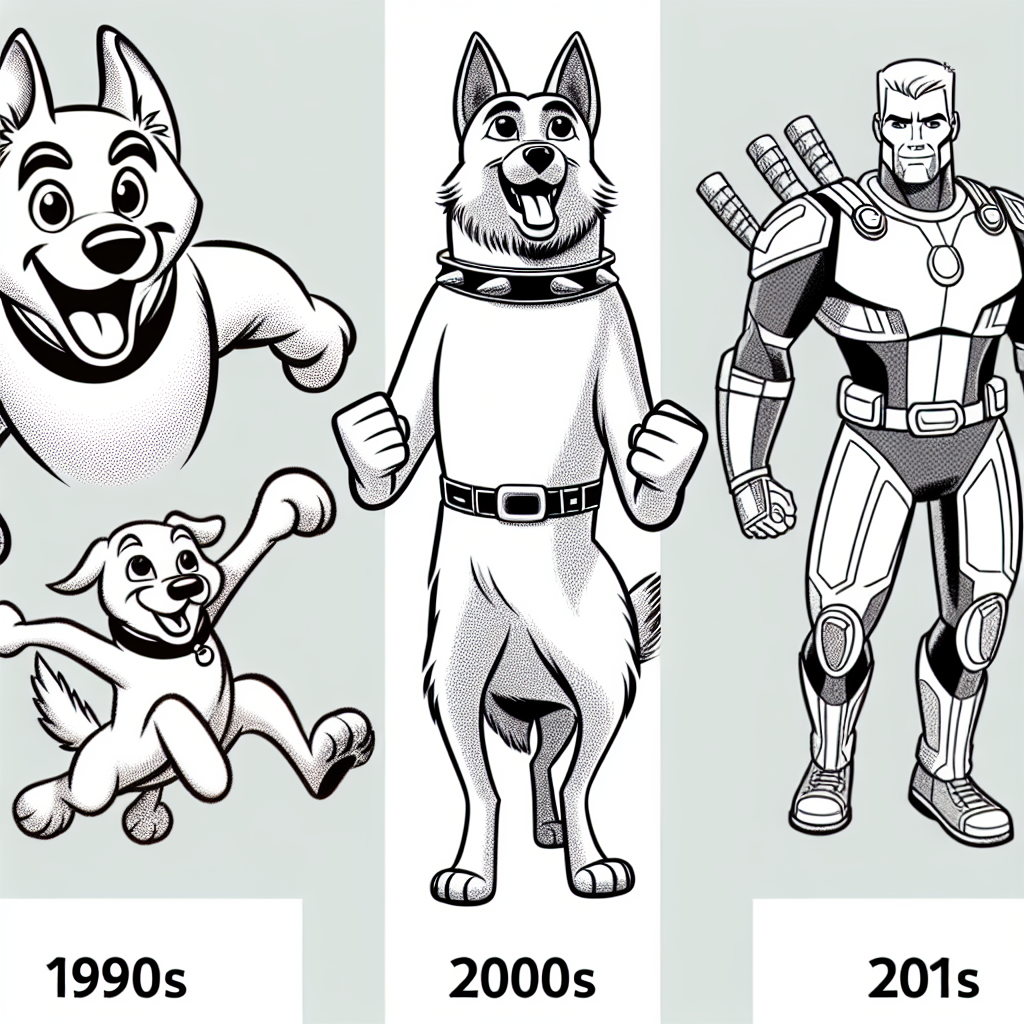Have you ever noticed how the cutest, most loyal characters in cartoons often come with a furry friend? From heroic hounds to mischievous mutts, the canine sidekick has trotted its way into our hearts, often stealing the show from their human counterparts. As we dive into the vivid world of Cartoon Network, we’ll explore how these lovable pups evolved alongside the network itself, adding charm, humor, and a sprinkle of canine wisdom to our favorite animated adventures.
The Beginnings: A Pioneering Era
Cartoon Network burst onto the scene in 1992, ready to captivate audiences with its eclectic blend of original programming and classic animations. This was an era where the anthropomorphized animal character played a crucial role in animation—especially dogs. Shows like “The Powerpuff Girls” and “Dexter’s Laboratory” kept the focus primarily on human characters, but an undercurrent of humorous canine presence began to flourish.
Take, for example, “Dexter’s Laboratory,” where the character of “E.E.E,” Dexter’s genetically engineered dog, appeared as a comedic sidekick. Though he was not a traditional canine sidekick, his quirky personality and antics foreshadowed the increasingly prominent role that dog characters would assume in future shows.
The Iconic Canine Duo: Scooby-Doo and Shaggy
What’s a discussion about canine sidekicks without mentioning the iconic duo of Scooby-Doo and Shaggy Rogers? Introduced in 1969 with “Scooby-Doo, Where Are You!” Scooby-Doo is not just any dog; he’s a Great Dane with a penchant for mischief and snacks. This character set the gold standard for the canine sidekick in the years to come. His charm and loyalty made him the perfect counterpart to the often absurd predicaments the gang found themselves in.
As Scooby-Doo transitioned into various series, including “What’s New, Scooby-Doo?” and “Scooby-Doo! Mystery Incorporated,” the love for historical continuity kept him relevant. Even in the 2020 reboot “Scooby-Doo and Guess Who?” he continues to shine, proving that the bond between a boy and his dog can transcend generations.
The Hierarchy of Canine Companions
As Cartoon Network proliferated during the late ‘90s and early 2000s, numerous canine characters made their way into various shows, each bringing unique traits and characteristics to the table. Here are some standout characters that showcased the versatility of the canine sidekick:
- Gromit from “Wallace & Gromit”: Although technically not a Cartoon Network character, Gromit made appearances on the network, exemplifying the clever and silent canine archetype, showcasing intelligence, problem-solving skills, and loyalty.
- Einstein from “Back to the Future: The Animated Series”: This time-traveling dog played a vital role, blending elements of humor with adventure and science fiction.
- Jake from “Adventure Time”: Jake, the Magical Dog, introduced us to a sidekick who is not only loyal but also has the magic of shape-shifting, opening doors to bizarre escapades.
- Snuffles from “The Powerpuff Girls”: Snuffles adds a comedic twist as a dog with aspirations of being a ‘genius’, proving that intellect and humor can be combined for great comedic effect.
Turning Point: The Unconventional Sidekicks
As the network grew bolder with its content, we noticed the emergence of unconventional canine sidekicks. These characters often broke the mold, providing humor through absurdity or representing the underdog in their stories.
One such beloved character is Spike, the bulldog from “The Amazing World of Gumball.” Spike provides comic relief through his gruff demeanor and oftentimes oblivious nature, leading him and Gumball into hilarious situations. The beauty of his character is that he can switch between hero and comic foil, enriching the narrative in ways that typical sidekicks struggle to achieve.
Crossover Appeal: The Network’s Influence on Culture
As Cartoon Network expanded its influence, so did the roles of canine sidekicks. Characters like Bea and Gibber from “The Amazing World of Gumball” broke traditional molds, showcasing dogs that were relatable and, above all, hilarious. The ability for these dogs to emulate human behaviors made them significant in terms of grabbing the audience’s attention.
The canine sidekick phenomenon on Cartoon Network also mirrored cultural changes. As audiences became more inclusive, so too did the roles of pets in this universe. Dogs were often used to navigate complex topics, showcasing lessons about friendship, loyalty, and understanding that resonate with people of all ages.
The Heartwarming Impact of Canine Companions
While they may be animated, these canine companions have an incredible impact on our emotional landscape. They represent unconditional love, loyalty, and rather comical quirks that bring joy to our screens. Whether they’re solving mysteries alongside their best friends or delivering moral lessons through their escapades, canine sidekicks remind viewers of the best qualities that dogs offer in real life.
Modern Adaptations: Relatable Canine Sidekicks in New Shows
As we moved further into the 21st century, the revitalization of classic shows and the creation of new ones demonstrated how the canine sidekick has adapted to stay relevant. In “Teen Titans Go!” we find the character of Dog Wonder who demonstrates not just humor but also facets of teamwork that resonate with the show’s overall themes of camaraderie and heroism.
In “Close Enough,” the show showcases the varied roles pets play in adult lives, addressing issues like responsibility, love, and even sheer chaos, all through the lens of their hilarious canine characters.
The Future of Canine Sidekicks on Cartoon Network
The evolution of the canine sidekick in Cartoon Network shows is a testament to the network’s understanding of narrative depth and audience connection. With advancements in animation and storytelling, it’s likely that we’ll see dogs of even more varied backgrounds and personalities taking center stage in the coming years.
The rise of diverse storytelling offers a fantastic opportunity for new canine companions who capture the essence of modern-day societal values. They may also tackle more profound themes regarding the relationship between humans and their canine buddies, reflecting the cultural dynamics and understanding that society holds today.
Conclusion: Embracing the Canine Spirit
Throughout the decades, the role of canine sidekicks in Cartoon Network’s animated series has morphed and flourished, moving beyond mere comic relief into respected characters with depth and narratives of their own. These furry friends have not only provided us with unforgettable laughs and lessons but have also served as friendly symbols of loyalty and companionship. As we continue to enjoy these shows, let’s take a moment to appreciate the lovable dogs who have barked their way into our hearts.
FAQ
What is the role of canine sidekicks in cartoons?
Canine sidekicks often provide comic relief, showcase loyalty, and sometimes even advance the plot. They often embody characteristics that resonate with audiences, such as friendship, unconditional love, and humor, making them integral parts of storytelling.
Why are dogs such popular sidekicks in animated shows?
Dogs are seen as loyal companions, making them relatable and appealing characters. Their personalities can be varied and quirky, lending themselves well to comedic situations and emotional arcs, which enrich the narrative dynamics of the shows they feature in.
How have modern cartoon shows changed the portrayal of canine sidekicks?
Modern cartoons tend to give canine sidekicks more depth and personality, allowing them to take part in significant storylines beyond mere comic relief. There is also a greater focus on diversity and relatability, reflecting real-world values and relationships.
Can you give examples of popular canine sidekicks from Cartoon Network?
Some popular canine sidekicks include Scooby-Doo from “Scooby-Doo,” Spike from “The Amazing World of Gumball,” Gromit from “Wallace & Gromit,” and Jake from “Adventure Time”. Each of these characters brings unique traits and humor to their respective shows.








+ There are no comments
Add yours